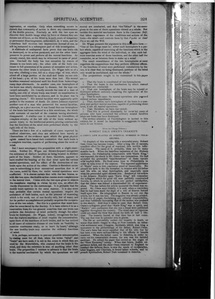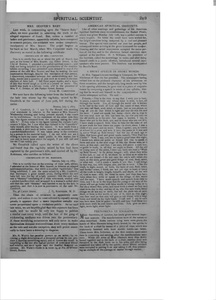< The Duality of the Mind (continued from page 3-246) >
or permanent disarrangement, unfocussed, as it were, and the Conscious Self receives two impressions instead of one, as will be instanced in a subsequent part of this investigation.
A multitude of undisputed facts prove that one brain can be destroyed, or its action paralyzed, and yet the other brain preserve its power and perform all the mental functions. As already stated, this result may be witnessed in cases of paralysis. One-half the body has lost sensation by reason of disease in one brain only; the other side of the body continues in full possession of its powers of sensation and action, because the other brain is uninjured. Dr. Wigan tells us of a boy who, climbing a tree, fell on a sharp edge of iron, which sliced off a large portion of the skull and brain on one side of his head; 4 oz of his brain were thus lost. His mental faculties remained uninjured until his death from hemorrhage many days afterwards. In another case, one hemisphere of the brain was wholly destroyed by disease, but the man conversed rationally. Dr. Conolly records the case of a man of family, one side of whose brain was found on examination to have been annihilated by an abscess, and in its place was “a yawning chasm.” His mental faculties were apparently quite perfect to the moment of death. Dr. James Johnson reported another case of a man who preserved his mental faculties, although, on a post mortem, it was found that one hemisphere of the brain had been reduced to a thin membrane, the whole solid contents of one-half of the cranium having absolutely disappeared. A similiar case is recorded by Cruveilhier, of complete atrophy of the left side of the brain without apparent injury to the intellectual powers, proving conclusively that the functions of the mind were performed wholly by the right side of the brain.
These are but a few of a multitude of cases reported by medical observers, and they are adduced here merely as illustrations of the evidence upon which the great physiologists named have based their contention that each brain is a complete machine, capable of performing alone the work of mind.
But I must accompany this proposition with a slight reservation. Neither Dr. Wigan nor Brown-Sequard recognizes the existence of distinct faculties as being located in distinct parts of the brain. Neither of them, therefore, appears to have studied the bearing of the dual mind upon the various mental operations, and the effect of the destruction of one brain upon the action of the other. Caution is therefore necessary in subscribing to their unreserved assertion that in all the cases, noted by them, the entire mental operations were unaffected. It is almost certain that with the two brains, as with the two eyes, the double action causes more completeness in the mental view. Vision with the two eyes gives to objects the roundness wanting in vision by one eye, an effect distinctly discovered by the stereoscope. It is probable that the double brain operates in the same manner. It is also more than probable that certain mental operations require the assistance of both brains, such as the process of reasoning, which is the work, not of one faculty only, but of many, and for its perfect accomplishment probably acquires the co-operation of the two minds. But this is a question that must hereafter be considered by the Society. It is here referred to as a reservation from the too general assertion that one brain can perform the functions of mind perfectly though the other brain be destroyed. Dr. Wigan, indeed, recognizes the fact that the highest exertions of mind require the concentration upon them of the exertions of both brains, and he has noticed in all cases of extensive disease of one brain an “inability to exercise continuous study, or to learn by heart,” although the one healthy brain may exercise the ordinary functions of mind.
It is, perhaps, necessary to prevent possible misconception by stating once for all that, when the terms “mind” anti “brain” are here used, it is not in the sense in which they are used by the Materialists, who contend that the brain is the mind, and deny the existence in man of anything other than brain. The proposition I venture to advance is that the brain is the material mechanism by which the operations we call mental are conducted, and that “the Mind” is the name given to the sum of these operations viewed as a whole. Bat besides this material mechanism there is the Conscious Self, that takes cognizance of the conditions and actions of the brain—the mind—and controls them by that Psychic or Soul Force we call the Will.
Dr. Wigan presents the argument in this collusive form:— “One of two things must be: either each hemisphere is a perfect whole, capable of exercising all the functions which in the aggregate form the mind of the individual, or else each hal must exercise some of those functions, and the other half the remainder, so as between them to make up a mind.
The exact resemblance of the two hemispheres at once negatives the suppositions that they perform different offices. If the functions of mind were performed cumulatively by the two, it is clear that, on being destroyed, portions of the mind only would be annihilated, and not the whole.”
The propositions sought to be maintained in this paper are:—
1. That the brain is constituted of two hemispheres.
2. That the brain is the mechanism by which menial operations are conducted.
3. That one hemisphere of the brain may be injured or destroyed without seriously impairing the operations of the other hemisphere.
4. That in such cases the mental operations also proceed without serious impediment.
5. That, therefore, each hemisphere of the brain is a complete and perfect mental machine, capable of performing alone most, if not all. mental operations.
6. That, therefore, we have two minds.
7. That this is proved abundantly by recorded cases of persons who have exercised the ordinary mental faculties when one brain has been destroyed.
The serious attention of Psychologists is invited to this subject, for it would be impossible to exaggerate its importance to our Science.
Robert Dale Owen's Insanity
A dispatch of this morning tells a sorrowful story. Robert Dale Owen has become insane. After a long life of earnest, unselfish effort for the good of mankind, this terrible infliction comes. The cause of it, probably, does not lie many months back. When the heartless imposture of the Holmes mediums, the Philadelphia conspirators with “Katie King,” was exposed, the shock to Mr. Owen was tremendous. He had accepted the pretended "manifestations” of these rascals with implicit faith. He lived some time in Philadelphia in order to miss none of the seances. The repeated apparitions of “Katie” were to him conclusive proof of immortality. He pinned his faith in the life hereafter, in reunion with his father and his wife, on what Spiritualism, and especially upon what his pretended spirit showed him. Reader, of his article in the Atlantic Monthly upon “Katie King” will remember the syllogism which the good old man painfully constructed therein, by which he proved, to his own perfect satisfaction, that the visitor was indeed a disembodied bit of supernaturalism. The day before the article appeared the fraud was exposed. Mr. Owen wept bitterly, it is said, when a conviction that he had been made the dupe of a trio of knave, forced itself upon him. He telegraphed to Boston to cut out the article, but it was too late. The magazine was already printed. A thin slip of paper, disclaiming any editorial responsibility, and thus ruthlessly increasing that of the author, was prefixed to the sketch. And thus it came to pass that Robert Dale Owen s syllogistic proof that “Katie King” was a spirit, and “Katie’s” own confession that she was a fraud were published together throughout the country. The mind once so vigorous could not stand the blow that shook the faith of half a lifetime. The insanity feared at that time has at last come. The sun that rose in splendor sets in gloom.
The life so sorrowfully ended—for insanity is death, or worse than death—began in 1804, at New Lennart, an industrial settlement near Glasgow, Scotland, which was long a monument to the philanthropy of his father, Robert Owen. The son’s fame has never equalled that of his sire, but he has been even more self-sacrificing in his efforts to benefit mankind. When the father came to America, in order to carry out his communistic dreams, the son was his faithful assistant. He edited the paper that served as the organ of the “New Harmony” colony. When that brave, foolish experiment failed, and the elder Owen returned to England to conduct like failures there, to sow the seeds of co-operation, labor leagues, and Chartism, to found infant schools, and to preach Spiritualism, Robert Dale remained in America.
Phenomena in England
Miss. Showers, of London, has lately given several important seances. The manifestations were of the nature so often described. Some curious tying tests were given, the hands of Miss Showers being firmly bound, by the spirits, to the back of a chair by means of a piece of rope, which was elaborately fastened with hard double knots—no twists. These knots Mrs. Schietter, at the first seance, spent some time in examining and untying. after the manifestations were over. While the arms of Miss Showers were thus firmly bound together and to the back of a chair, another chair was threaded in the dark room on to her arms, and after being examined was taken off by the spirits; about fifteen seconds were occupied in putting it on and taking it off, thus presenting an example of the passage of matter through matter.
Editor's notes
Sources
-
Spiritual Scientist, v. 2, No. 19, July 15, 1875, p. 221
-
Spiritual Scientist, v. 2, No. 19, July 15, 1875, p. 219



